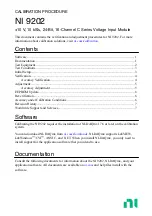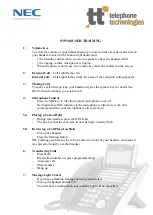
5
WMU-116 Radio Microphone
Setting Up
Insert the supplied AA batteries into the transmitter by carefully unscrewing the base of the
handheld or opening the flap of the bodypack to reveal the battery compartment. Insert the batteries
(ensuring that + and - are the correct way round for each cell) and carefully replace the cover.
For neckband or lavalier microphones, connect the microphone lead into the bodypack, ensuring it is securely
pushed into the socket.
The receiver antenna may be connected directly to the BNC connector on the rear panel or
alternatively front-mounted onto rack ears (see below)
If the receiver is to be rack-mounted, place the supplied rack ears against each side of the receiver
and fix securely with 2 screws in each. These rack ears have a hole for front-mounting the antenna
and a BNC extension lead for fixing into the hole. This should be connected to the BNC on the rear
panel, creating a front socket for the antenna to connect onto.
A choice of unbalanced 6.3mm jack or balanced XLR output is available on the rear panel of the
receiver. Connect the jack or XLR (optional) lead to the relevant output connector, turn down the
volume of any equipment (mixer, amplifier etc.) that the signal will be fed into and then connect the
jack or XLR to the equipment.
Position the receiver within the best available line of sight to the transmitters and connect the DC
jack of the supplied power adaptor to the receiver and the plug top to the mains outlet.
Operation
Turn microphone levels down on the receiver and switch on power on the front panel of the receiver.
Warning! - take care not to point microphones towards speakers – this can cause damaging feedback
(loud whistle or howling noise) – try to point microphones away from the speaker cabinets.
For the handheld version, move the switch on the handheld transmitter upward to switch it on and
the LCD display should light for a few seconds, showing the carrier frequency and battery status.
For the bodypack transmitter, press and hold the front on/off button until the display lights up for a
few seconds, ensuring that the Mute switch is off. The display will show the current carrier frequency
and battery status. The transmitter frequency should match the frequency on the receiver. If not,
see “Tuning” below.
Gradually increase the microphone level on the receiver, then increase the volume on the mixer or
amplifier until the sound from each microphone can be heard through the equipment.
By Pressing the Mode button twice on the belt pack, you can set the input sensitivity of the transmitter. This
means you can connect devices with a different output level to the supplied microphone, or turn the level down
if the device is overloading.
After pressing the button twice you will see the left hand bars flash on the screen. Using the set button you can
select Line, Low, Medium, or High sensitivity. Line being the least sensitive.
Tuning
The carrier frequency may be selected on the receiver unit by pressing the SET button, which
causes the GROUP label to flash in the display. Buttons 16 & 17can be used to select the
Group from 1 to 7. Pressing the SET button again causes the CHANNEL label to flash. The channel
can be selected within a group using buttons 16 & 17.
Groups 1 to 6 have between 3 and 5 preset channels, whilst Group 7 allows access to all 81 possible
frequencies. Depending upon any other radio signals in the vicinity of the operating environment,
one particular Group may offer a better channel spacing than another and this should be determined
by experimentation. If a particular group of frequencies results in poor reception or interference, try


























